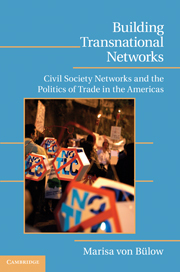Book contents
- Frontmatter
- Contents
- List of Figures
- List of Tables
- Acknowledgments
- Part One Civil Society Organizations and Their Pathways to Transnationality
- Part Two The Politicization of Trade
- Part Three The Dynamics of Networks
- Part Four Organizational Pathways to Transnationality
- Part Five The Search for Ideational Pathways
- 9 ALTERNATIVES FOR THE AMERICAS
- 10 TRANSNATIONAL COLLECTIVE ACTION IN DYNAMIC POLITICAL CONTEXTS
- 11 CONCLUSIONS: AGENCY, NETWORKS, AND COLLECTIVE ACTION
- Main Abbreviations Used
- Appendix A Lists of Interviews
- Appendix B Social Network Questionnaire (United States)
- Bibliography
- Index
10 - TRANSNATIONAL COLLECTIVE ACTION IN DYNAMIC POLITICAL CONTEXTS
Published online by Cambridge University Press: 05 October 2010
- Frontmatter
- Contents
- List of Figures
- List of Tables
- Acknowledgments
- Part One Civil Society Organizations and Their Pathways to Transnationality
- Part Two The Politicization of Trade
- Part Three The Dynamics of Networks
- Part Four Organizational Pathways to Transnationality
- Part Five The Search for Ideational Pathways
- 9 ALTERNATIVES FOR THE AMERICAS
- 10 TRANSNATIONAL COLLECTIVE ACTION IN DYNAMIC POLITICAL CONTEXTS
- 11 CONCLUSIONS: AGENCY, NETWORKS, AND COLLECTIVE ACTION
- Main Abbreviations Used
- Appendix A Lists of Interviews
- Appendix B Social Network Questionnaire (United States)
- Bibliography
- Index
Summary
In December 2007, the U.S. Congress approved the free trade agreement between Peru and the United States. This agreement did not have large economic impacts in the region, nor did it open the way to the resuscitation of hemispheric talks. What makes it an interesting story, though, is that it passed by a large bipartisan vote, in spite of rising skepticism about free trade agreements in the last few years and the recent election of a new majority of Democratic legislators. In 2001 the Trade Promotion Authority (TPA) bill had passed by only one House vote. In 2006 the U.S.–Central America Free Trade Agreement (CAFTA) passed by just two votes. However, U.S. civil society organizations (CSOs) that had fought adamantly these previous initiatives were divided on how to respond to the Peru free trade initiative. For the first time since the North American Free Trade Agreement (NAFTA) was approved, the American Federation of Labor–Congress of Industrial Organizations (AFL-CIO) decided not to oppose a new trade deal negotiated in the Americas. This position can be understood only in light of the changes in the political environment in the United States.
The Democratic Party won the majority of seats in Congress in the 2006 elections, in which many of the contenders gained votes by criticizing NAFTA-like agreements in local campaigns (Destler 2007: 1).
- Type
- Chapter
- Information
- Building Transnational NetworksCivil Society and the Politics of Trade in the Americas, pp. 176 - 189Publisher: Cambridge University PressPrint publication year: 2010

